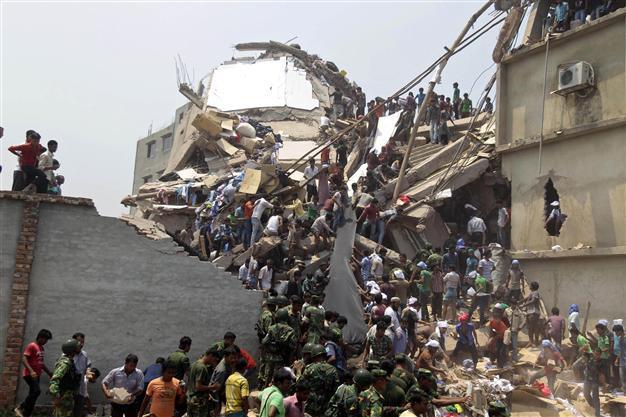113 killed as Bangladesh building collapses
SAVAR, Bangladesh – Agence France-Presse

Rescue workers and people look for survivors after an eight-story building housing several garment factories collapsed in Savar, near Dhaka, Bangladesh, Wednesday, April 24, 2013. AP Photo
Rescue workers were searching for survivors late into the night April 24 after a building containing five garment factories collapsed in Bangladesh, killing at least 113 people.Only the ground floor of the eight-storey Rana Plaza in Savar town just outside the capital Dhaka remained intact when the block - which one minister said was illegally constructed - imploded during the early morning hours.
Armed with concrete cutters and cranes, hundreds of fire service and army rescue workers struggled in the hope of finding more survivors in the mountain of concrete and mangled steel, which resembled the aftermath of an earthquake.
Corpses and the injured were pulled from the higher reaches of the pile of flattened floors via makeshift slides made from cloth that just hours earlier was being cut into shirts and trousers for export to Western markets.
"The whole building collapsed like a pancake within minutes. Most workers did not have any chance to escape," national fire department chief Ahmed Ali told AFP. "Many people are still trapped". Fire fighters and soldiers cut through the building's collapsed sixth floor and managed to rescue 20 people eight hours after the accident, he said.
"We will continue searching for survivors through the night, for as long as it takes," he said.
Deputy chief of Dhaka police A.B.M Masud Hossain told AFP that at least 113 people have died in the disaster. "But the toll will be higher because some relatives took bodies without informing police," he said.
Building used as clothing factories
Two of the factories in the building - New Wave Style and New Wave Bottoms - were making clothing for retailers Mango of Spain and Benetton of Italy, according to campaign group Bangladesh Center for Workers Solidarity. A spokesman for Benetton however said they "are not suppliers for Benetton".
A spokeswoman for Mango, Marta Soler Morera, told AFP by email that it did not have any suppliers at the building, "although we did have contacts with one of them to produce a test production, as we do with several suppliers".
Tessel Pauli, a spokeswoman for the Amsterdam-based Clean Clothes Campaign, said the accident was "symptomatic" of problems in Bangladesh where foreign buyers often overlook safety problems in their hunt for higher profits.
The accident will likely pile more pressure on the bargain-hunters as the disaster came just months after a blaze in the Tazreen factory, which was making apparel for Walmart and others, left 111 people dead.
In the wake of that tragedy, the US threatened to cut some duty-free facilities for Bangladeshi products. The Muslim-majority country has the second-biggest clothing industry in the world, but it is plagued by regular accidents and demonstrations by workers demanding better wages and working conditions.
A day of mourning
Prime Minister Sheikh Hasina announced a national day of mourning for April 25 when flags will fly at half-mast in memory of the victims.
Hiralal Roy, a senior emergency ward doctor at the nearby Enam Hospital where victims were being taken, said at least 1,000 injured people had been treated at the hospital. "The toll will rise as the condition of some of the injured was critical," he told AFP, adding the hospital had appealed for emergency blood donations.
Bangladesh Garment Manufacturers and Exporters Association said five factories were inside the building and together they employed around 3,000 workers.
Local media said the owner of the building was a local youth wing chief of the ruling party. He was rescued alive from the rubble.
Building collapses are relatively common in Bangladesh as developers often flout construction regulations when erecting multi-storey structures. More than 70 people were killed when a multi-storey garment factory collapsed in the Savar area in 2005.
















